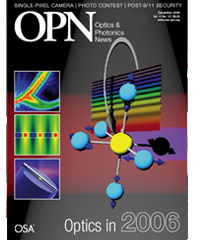
December 2006 Issue
Feature Articles
Optics in 2006 Introduction
The areas covered in 2006 include array detectors, Bloch oscillations, coherent imaging, diffractive optics, imaging, metamaterials, nonlinear optics, optical beams, opto-mechanics, polarization, Raman spectroscopy, soft X-rays and ultrafast science.
by Bob D. GuentherArray Detectors
Fabrics that “See”: Photosensitive Fiber Constructs.
by Ayman F. Abouraddy, Ofer Shapira, Mehmet Bayindir, Jerimy Arnold, John D. Joannopoulos and Yoel FinkBloch Oscillations
Photonic Bloch Oscillations and Zener Tunnelling
by Henrike Trompeter, Andreas Bräuer, Anton S. Desyatnikov, Yuri S. Kivshar, Wieslaw Krolikowski, Falk Lederer, Dirk Michaelis, Dragomir N. Neshev, Thomas Pertsch, Ulf Peschel, Ulrich Streppel and Andrey A. SukhorukovCoherent Imaging
Variable Coherence Allows Subwavelength Resolution Sensing.
by E. Baleine and A. DogariuDiffractive Optics
Computer-Generated Volume Holograms Optimize Degrees of Freedom in 3D Aperiodic Structures.
by Wenjian Cai, Timothy D. Gerke, Theodore J. Reber, Ariel Libertun and Rafael PiestunImaging
Localizing Defects on Circuits Using High-Resolution OFT
by Carlo Mar Blanca, Vernon Julius Cemine, Bernardino Buenaobra and Caesar SalomaMetamaterials
Nano-Dispersed Liquid Crystal with Tunable Negative-Zero-Positive Refractive Indices
by I.C. Khoo, D.H. Werner and A. DiazNonlinear Optics
Supercontinuum Generation in Sub-Centimeter Lengths of High-Nonlinearity Photonic Crystal Fibers
by Fiorenzo G. Omenetto, Natalie A. Wolchover, Mackenzie R. Wehner, Matt Ross, Anatoly Efimov, Antoinette Taylor, V. Ravi K. Kumar, Alan K. George, Jonathan C. Knight, Nicolas Y. Joly and Philip St. J. RussellOptical Beams
White Light Takes Shape.
by Pascal Fischer, Ewan M. Wright, Tom Brown, Wilson Sibbett, Jill E. Morris, Carlos López-Mariscal, Antonia E. Carruthers and Kishan DholakiaOpto-mechanical
Fiber-Top Cantilevers: A New Sensor on the Tip of a Fiber
by Davide Iannuzzi, Szabolcs Deladi and Michael ElwenspoekPolarization
Mueller Matrix Approach for Discriminating Optical Rotation
by S. Manhas, M.K. Swami, P. Buddhiwant, N. Ghosh, P.K. Gupta and K. SinghRaman Spectroscopy
Large-Aperture Raman Spectroscopy for Quantitative Chemometrics
by Scott T. McCain, Michael E. Gehm, Yanqia Wang, Nikos P. Pitsianis and David J. BradySoft X-ray
High Harmonic Generation from Ions in a Capillary Discharge Plasma Waveguide
by David M. Gaudiosi, Brendan Reagan, Tenio Popmintchev, Michael Grisham, Mark Berrill, Oren Cohen, Barry C. Walker, Margaret M. Murnane, Henry C. Kapteyn and Jorge J. RoccaUltrafast
As we become more able to control the length and accuracy of optical pulses, the field is expanding into new uses for ultrashort pulses.
by Luis Miaja-Avila, Guido Saathoff, Chifong Lei, Martin Aeschlimann, John L. Gland, Margaret M. Murnane and Henry C. KapteynDepartments and Columns
JOSA B: Optical Physics
When the series of the Journal of the Optical Society of America (JOSA) ended in December 1983 and the first issue of JOSA A appeared in January 1984, Robert Terhune had achieved only half of his grand scheme to revamp JOSA. Now it was time to focus on JOSA B.
Talking to your Government Officials: Why It Matters
I’ve learned a lot during my tenure as chair of OSA’s Public Policy Committee. Not only is it possible for individuals to make a difference in the lawmaking process, it happens regularly. Scientists and their constituents matter to government decision-makers. Their insights matter. Their opinions matter.
What Girls Need to Succeed in Science, Technology and Math
The root of the problem with engaging girls in science, technology, engineering and math is that young women often feel that these fields are difficult to understand and almost impossible to master. While we know this isn’t true, it is becoming all the more apparent that we have to reach young women and inspire a passion for these fields at an early age.
Post-9/11 Security: Better for Scientists, but not Perfect
Some post-9/11 security measures may have had the unintended effect of slowing scientific progress. Science advocates today say the situation is improving, but that too many limitations remain and that the implementation of legitimate restrictions should be fine-tuned.
And the Winners Are ... Results from OPN's After Image Photo Contest.
Earlier this year, OPN invited its readers to participate in our fi rst ever After Image Photo Contest. We were delighted to receive 34 submissions that capture compelling aspects of laser science, atmospheric optics, astronomy, microscopy, optical coatings, optical design and more.


![A multiplexed image of a human tonsil acquired. [NIAID] using the iterative bleaching extends multiplexity (IBEX) method.](https://opnmedia.blob.core.windows.net/$web/opn/media/images/articles/2024/0424/departments/202404-cover-web.jpg?ext=.jpg)
